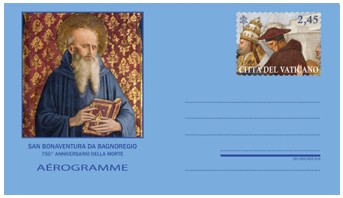
Home


 Saint Bonaventure, Seventh Century of Death Thirteenth Century Woodcuts 40L: Civita Bagnoregio 90L: Tree of Life 220L: Saint Bonaventure Scott 558-560 (1974) July 15 is the Feast of Saint Bonaventure. The feast falls on the anniversary of his death in 1274. Born Giovanni di Fidanza in Bagnoregio (located near Orvieto, Italy) in 1221, the future Saint Bonaventure entered the Franciscan Order in 1243. He studied in Paris, receiving his license to teach in 1248. In 1253 Bonaventure became Master of the Franciscan school at Paris and then Master-General of the Franciscan Order in 1257. He is considered as the ‘second founder’ of the Franciscans at a time of factionalism in the Order’s organization after St. Francis (d. 1226). Historian David Farmer states: "[Bonaventure] staunchly defended Franciscan ideals, but instead, against the teaching of Francis, on the serious need for study, and hence on the need for possession books and buildings. He confirmed the existing practice of the Friars, studying and teaching in the universities. He saw their role in the church as a whole as completing the work of diocesan clergy by preaching and spiritual direction…."He was a ‘moderate’ among other Franciscans and rejected the extreme position of the ’Spiritual Franciscans’ who advocated poverty above learning. David Farmer suggests "his own ideals of simplicity, frugal poverty, diligence, and detachment from the rich as well as from riches were realized in his own life." Dawn Marie Beutner notes his leadership created an environment that lessened factionalism in the order and enforced the Order’s discipline without harshness. Bonaventura would go on to write a biography of St. Francis, which became the official version. Bonaventure was instrumental in procuring the election of Pope Gregory X. Despite initially refusing an appointment as archbishop, Gregory insisted and awarded him the title of Cardinal Bishop of Albano. The pope also insisted that Bonaventure attend the Second Council of Lyon in 1274. While there, his significant contributions led to a union of the Greek and Latin churches, and he preached a Mass of Reconciliation on behalf of the effort. While in Lyon, Bonaventure died suddenly on July 15, 1274, a death occurring under suspicious circumstances (it has been rumored that he was poisoned). Coincidentally, St. Thomas Aquinas died on March 7, 1274, while on his way to Lyon. Bonaventure was canonized on April 14, 1482 by Pope Sixtus IV, and declared a Doctor of the Church in 1588 by Pope Sixtus V. He is often referred to as the "Seraphic Doctor" because of the ‘beauty and brilliance of his writings.’ He has been honored around the world, with many churches, schools and religious institutions named in his honor, including St. Bonaventure University, which is administered by the Franciscan order and is located in Allegany, New York. In addition to the 1974 stamps issued shown at the top of the article, the 2024 Vatican City aerogramme commemorated the 750th anniversary of the death of Saint Bonaventure:   Saint Bonaventure: 750th Anniversary of Death 2024 Aerogramme and Special Postmark REFERENCES: |